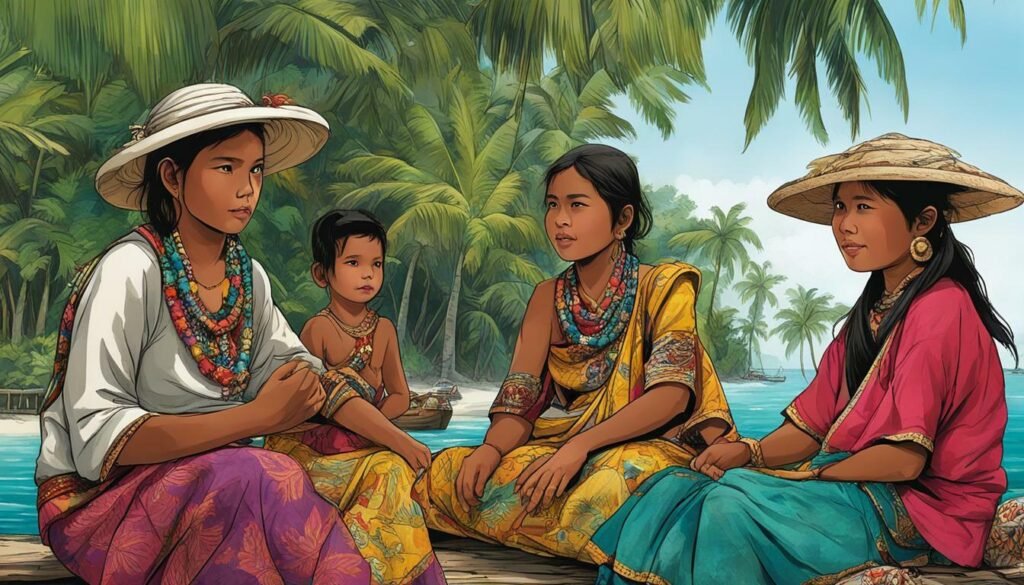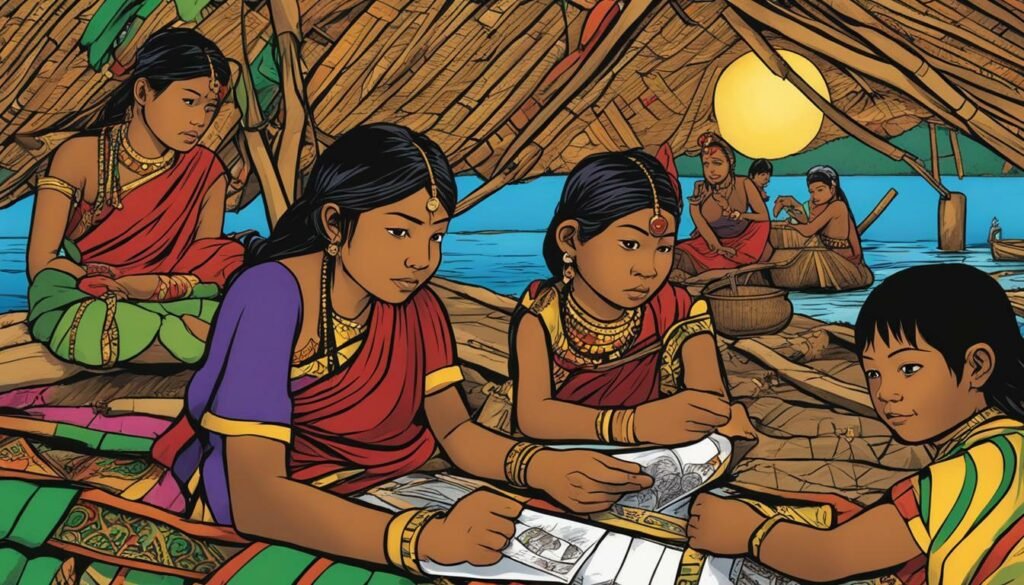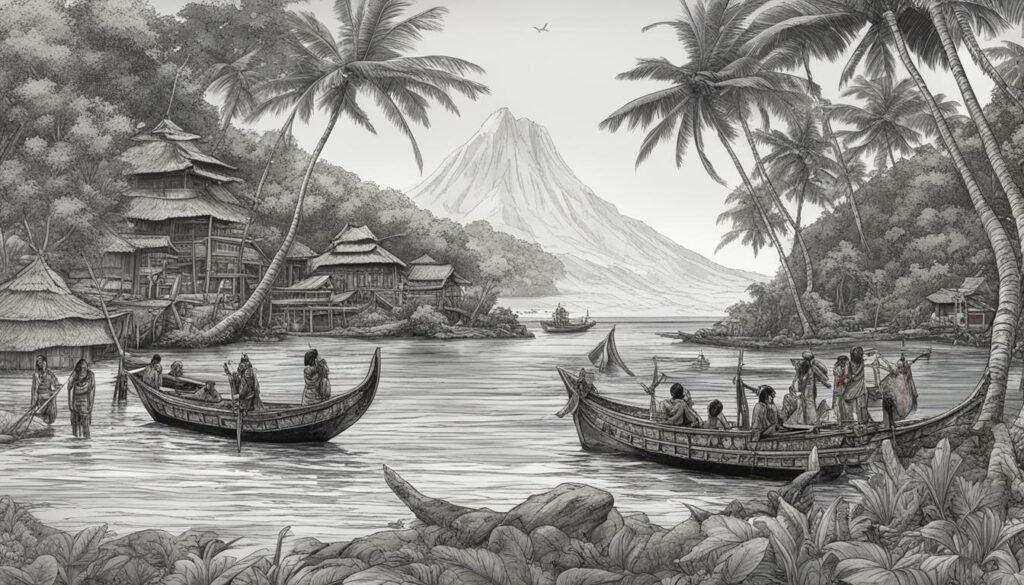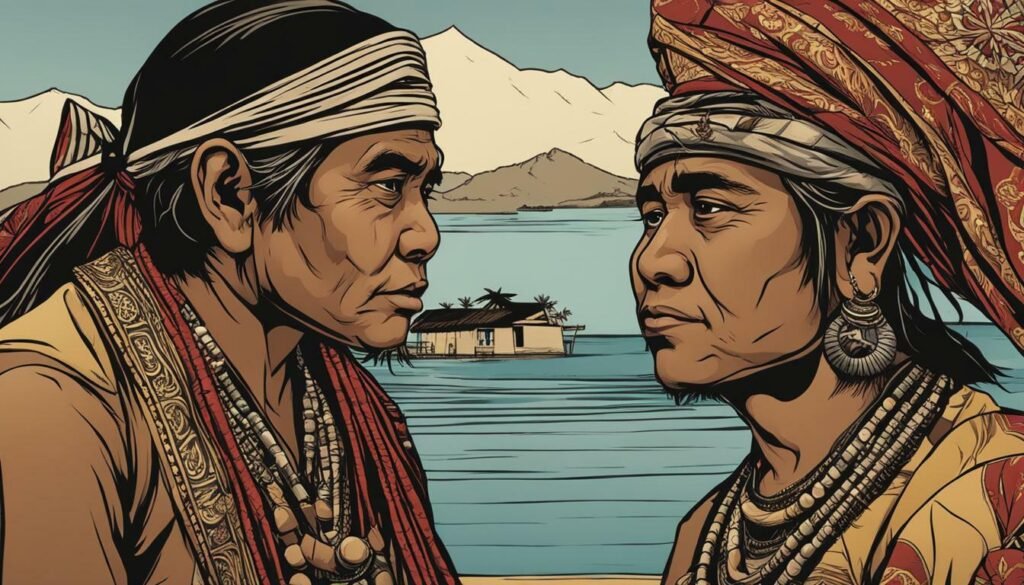The Sama-Bajau Language is a unique linguistic heritage spoken by sea-dwelling communities in the Philippines. This fascinating language is part of the Austronesian language family and has its roots in the Barito region of southeast Borneo. The Sama-Bajau peoples, known for their close association with the sea, have a nomadic lifestyle that has influenced the development of their language.
- The Sama-Bajau Language is spoken by sea-dwelling communities in the Philippines.
- It belongs to the Austronesian language family and has its origins in southeast Borneo.
- The Sama-Bajau peoples have a nomadic lifestyle, which has influenced the development of their language.
- There are several dialects within the Sama-Bajau languages, including Balangingi, Central Sama, Southern Sama, Pangutaran Sama, Mapun, Yakan, Abaknon, Indonesian Bajau, and West Coast Bajau.
- The Sama-Bajau languages have undergone contact-induced changes due to interactions with other languages, particularly the Central Philippine languages.
The Sama-Bajau Peoples and Their Languages
The Sama-Bajau peoples, found in the Philippines, Indonesia, and Malaysia, speak various dialects of the Sama-Bajau languages. These languages are part of the Austronesian language family, which includes other languages spoken across Southeast Asia and the Pacific. Within the Sama-Bajau languages, there are several distinct dialects, each with its own unique characteristics. Some of these dialects include Balangingi, Central Sama, Southern Sama, Pangutaran Sama, Mapun, Yakan, Abaknon, Indonesian Bajau, and West Coast Bajau.
The Sama-Bajau peoples have a rich linguistic and cultural heritage. These languages have their origin in the Barito region of southeast Borneo, and over time, they have spread across different regions as the Sama-Bajau peoples migrated and established communities along the coasts and islands. The close association of the Sama-Bajau with the sea has shaped their way of life, as they are known for their seafaring skills and reliance on marine resources for their sustenance.
Language contact has played a significant role in shaping the Sama-Bajau languages. Their interactions with other languages, particularly the Central Philippine languages, have led to changes in vocabulary, grammar, and pronunciation. The Sama-Bajau peoples’ nomadic lifestyle and settlements in different areas have facilitated language contact and the exchange of linguistic features.
The Sama-Bajau languages exhibit unique phonological features that distinguish them from other languages in the region. For example, they have a seven-vowel system, which is relatively rare among Austronesian languages. Vowel neutralization, where certain vowel distinctions are not consistently maintained, is also observed in the Sama-Bajau languages. These distinctive sound patterns contribute to the distinct identity of these languages.

| Dialect | Region |
|---|---|
| Balangingi | Sulu Archipelago, Philippines |
| Central Sama | Tawi-Tawi, Philippines |
| Southern Sama | Malaysia, Indonesia |
| Pangutaran Sama | Pangutaran Island, Philippines |
| Mapun | Mapun Island, Philippines |
| Yakan | Basilan, Philippines |
| Abaknon | Capul Island, Philippines |
| Indonesian Bajau | North Kalimantan, Indonesia |
| West Coast Bajau | West Coast Sabah, Malaysia |
Further research is needed to delve deeper into the syntax and language contact in the Sama-Bajau languages. Understanding the structure and grammar of these languages will not only shed light on the linguistic diversity of the region but also contribute to the preservation and documentation of the Sama-Bajau cultural heritage.
Nomadic Lifestyle and Settlements
The Sama-Bajau peoples have traditionally led a nomadic lifestyle, but some communities have now settled down. Due to their close association with the sea, the Sama-Bajau have a deep connection to maritime activities such as fishing, pearl diving, and boat-building. Their nomadic lifestyle was driven by the need to follow seasonal fish migrations and find new sources of food and trade. This lifestyle allowed them to explore vast stretches of the ocean and establish temporary settlements on small islands or coastal areas.
While many Sama-Bajau communities still maintain their nomadic way of life, some have transitioned into permanent settlements. These settlements, known as Badjo villages, are usually situated along the coast or near bodies of water. They consist of stilt houses built above the water, providing easy access to fishing grounds and facilitating travel by boat. These settlements reflect the resourcefulness and adaptability of the Sama-Bajau peoples in finding sustainable ways to live in harmony with their environment.
Embedded within the Sama-Bajau culture is a strong sense of community and kinship ties. The settlements serve as social hubs where families and extended relatives gather, share meals, and engage in cultural activities. Traditional ceremonies and rituals are held to celebrate important events and reinforce the cultural identity of the Sama-Bajau peoples. These settlements also provide a sense of stability and security, ensuring the continuity of their language and cultural practices for future generations.

In summary, the Sama-Bajau peoples’ nomadic lifestyle and settlements are integral to their identity and way of life. While they have traditionally roamed the seas, some communities have established permanent settlements known as Badjo villages. These settlements serve as social and cultural centers, fostering a strong sense of community and preserving the unique Sama-Bajau language and traditions.
| Nomadic Lifestyle | Settlements |
|---|---|
| – Close association with the sea | – Established along the coast or near bodies of water |
| – Fishing, pearl diving, and boat-building | – Stilt houses built above the water |
| – Following fish migrations | – Social hubs for community gatherings |
Language Contact and Influences
The Sama-Bajau languages have undergone contact-induced changes through interactions with other languages, especially the Central Philippine languages. These languages have been influenced by the languages spoken by neighboring communities, resulting in linguistic variations and unique characteristics.
Language contact occurs when different language communities come into regular contact and communicate with each other. As a result of this contact, words, grammar structures, and pronunciation can be borrowed or influenced by one another. In the case of the Sama-Bajau languages, their interactions with Central Philippine languages have played a significant role in shaping the evolution of these languages.
Central Philippine languages, such as Cebuano and Tagalog, have had a profound impact on the Sama-Bajau languages due to their extensive use and dominance in the region. This language contact has resulted in changes in vocabulary, grammar, and pronunciation. Loanwords from Central Philippine languages have been incorporated into the Sama-Bajau lexicon, enriching the vocabulary and expanding the linguistic resources of these languages. Similarly, grammatical structures and pronunciation patterns have been influenced by the Central Philippine languages, leading to noticeable variations in the Sama-Bajau languages.
| Language | Language Family | Region |
|---|---|---|
| Central Philippine languages | Austronesian | Philippines |
| Sama-Bajau languages | Austronesian | Philippines, Indonesia, Malaysia |
Despite these influences, the Sama-Bajau languages have retained their distinctiveness and unique features. They continue to be spoken by the Sama-Bajau peoples, who have preserved their rich linguistic heritage despite the challenges posed by modernization and globalization.

The Sama-Bajau languages exhibit unique phonological features, including a seven-vowel system and vowel neutralization. These distinctive characteristics contribute to the rich and diverse linguistic landscape of the Sama-Bajau people.
One notable aspect of the Sama-Bajau languages is their seven-vowel system. Unlike many other languages that typically have five vowels, the Sama-Bajau languages have expanded their vowel inventory to include two additional vowels. This expanded system allows for a greater range of vowel sounds and adds complexity to the pronunciation of words.
Another intriguing phonological feature is vowel neutralization. This phenomenon occurs when different vowel sounds are reduced to a single vowel sound under certain conditions. In the Sama-Bajau languages, vowel neutralization can be observed in specific contexts, leading to a change in the pronunciation of words.

Understanding the phonological features of the Sama-Bajau languages provides valuable insights into the linguistic diversity of the Philippines. These features highlight the intricate nature of language, showcasing the complexity and beauty of the Sama-Bajau languages.
Table: Phonetic Vowel Inventory in Sama-Bajau Languages
| Vowel | Front | Central | Back |
|---|---|---|---|
| High | i | u | |
| Mid | e | o | |
| Low | a |
Syntax and Language Contact
Further research is required to delve into the syntax and language contact phenomena within the Sama-Bajau languages. These languages, spoken by the Sama-Bajau peoples in the Philippines, Indonesia, and Malaysia, have unique linguistic characteristics that deserve closer examination.
As part of the Austronesian language family, the Sama-Bajau languages have their origin in the Barito region of southeast Borneo. Throughout their history, these languages have come into contact with other languages, particularly the Central Philippine languages. These language interactions have resulted in dialectal variations and changes in the grammatical structure of the Sama-Bajau languages.
One area of study that requires further exploration is the syntax of the Sama-Bajau languages. Syntax refers to the arrangement of words and phrases to create meaningful sentences. Understanding the syntactic features of these languages can provide insights into their unique grammatical structures and the ways in which they differ from other languages in the region.
| Language Feature | Example |
|---|---|
| Vowel neutralization | In certain contexts, vowel sounds in the Sama-Bajau languages may become neutralized, resulting in the loss of phonemic distinction. |
| Seven-vowel system | The Sama-Bajau languages employ a seven-vowel system, which is distinct from many other languages in the area. |
| Word order variation | The Sama-Bajau languages exhibit flexibility in word order, with variations in subject-verb-object (SVO) and verb-object-subject (VOS) structures. |
Studying the syntax and language contact in the Sama-Bajau languages can not only enhance our understanding of these languages but also shed light on the history and cultural interactions of the Sama-Bajau peoples. By documenting and analyzing the syntactic features of these languages, linguists can contribute to the preservation and revitalization efforts for this unique linguistic heritage.

Among the different dialects of the Sama-Bajau languages, Balangingi, Yakan, and Abaknon have distinct linguistic features. These dialects reflect the rich diversity within the Sama-Bajau language family and provide valuable insights into the cultural and historical background of the communities that speak them.
The Balangingi dialect is spoken primarily by the Balangingi people in the Sulu Archipelago. It is characterized by its unique vocabulary and pronunciation, influenced by the historical interactions of the Balangingi people with neighboring communities. The dialect exhibits phonological variations that set it apart from other Sama-Bajau dialects, making it a fascinating area of study for linguists.
The Yakan dialect is spoken by the Yakan people in the Basilan province of the Philippines. It is known for its distinctive grammatical structures and lexical items. The Yakan dialect has been influenced by the Tausug language, resulting in a fascinating blend of linguistic elements that reflect the historical and cultural interactions between these communities.
The Abaknon dialect is spoken by the Abaknon people in the Capul and Dalupiri Islands in the northern part of the Philippines. It is considered one of the most unique dialects within the Sama-Bajau languages due to its isolated geographical location. The Abaknon dialect exhibits phonological, lexical, and grammatical features that set it apart from other dialects, serving as a testimony to the linguistic richness of the region.

These dialects play a crucial role in preserving the linguistic diversity of the Sama-Bajau languages. They serve as a testament to the rich cultural heritage of the Sama-Bajau peoples and provide linguists and researchers with valuable data for further exploration and understanding of their unique language systems.
| Dialect | Location | Linguistic Features |
|---|---|---|
| Balangingi | Sulu Archipelago | Distinct vocabulary and pronunciation |
| Yakan | Basilan province | Unique grammatical structures and lexical elements influenced by Tausug language |
| Abaknon | Capul and Dalupiri Islands | Phonological, lexical, and grammatical features reflecting isolated geographical location |
“The dialects within the Sama-Bajau languages offer a glimpse into the linguistic richness and cultural diversity of the communities that speak them. Exploring these dialects not only enhances our understanding of language contact and influence but also provides insights into the unique identities and histories of the Sama-Bajau peoples.”
– Linguist, Dr. Maria Santos
Indonesian Bajau and West Coast Bajau Dialects
The Indonesian Bajau and West Coast Bajau dialects are prominent variations within the Sama-Bajau languages, found in specific regions. These dialects showcase the linguistic diversity and cultural richness of the Sama-Bajau peoples.
The Indonesian Bajau dialect is primarily spoken in Indonesia, particularly in the islands of Sulawesi, Sumatra, and Kalimantan. It exhibits distinct phonological and grammatical characteristics that set it apart from other Sama-Bajau dialects. The language is influenced by the surrounding Indonesian languages, resulting in a unique blend of linguistic features.
On the other hand, the West Coast Bajau dialect is spoken by the Sama-Bajau communities along the west coast of Sabah, Malaysia. This dialect has its own set of phonetic and grammatical variations, reflecting the influence of neighboring languages such as Malay and Kadazan-Dusun. It is important to note that West Coast Bajau is not to be confused with the Indonesian Bajau dialect, as they differ in terms of geographical distribution and linguistic characteristics.
To further illustrate the linguistic differences between these dialects, let’s take a look at the following table which highlights some key distinctions:
| Dialect | Vocabulary | Pronunciation |
|---|---|---|
| Indonesian Bajau | Mata (eye) | [mata] |
| West Coast Bajau | Palu (hammer) | [pə.lu] |
| Indonesian Bajau | Kembang (flower) | [kəm.baŋ] |
| West Coast Bajau | Bunga (flower) | [bu.ŋa] |
These examples demonstrate the lexical and phonetic variations between Indonesian Bajau and West Coast Bajau dialects, highlighting the intricate linguistic tapestry within the Sama-Bajau languages.

As we delve deeper into the world of the Sama-Bajau languages, it becomes evident that the Indonesian Bajau and West Coast Bajau dialects play a significant role in preserving the cultural heritage and linguistic diversity of the Sama-Bajau peoples.
Conclusion
In conclusion, the Sama-Bajau Language is a significant linguistic heritage that reflects the rich cultural diversity of the sea-dwelling communities in the Philippines. The Sama-Bajau peoples, spread across the Philippines, Indonesia, and Malaysia, speak various dialects within the Sama-Bajau languages, including Balangingi, Central Sama, Southern Sama, Pangutaran Sama, Mapun, Yakan, Abaknon, Indonesian Bajau, and West Coast Bajau. These languages, belonging to the Austronesian language family, have their roots in the Barito region of southeast Borneo.
The Sama-Bajau peoples have a unique nomadic lifestyle, closely tied to their affinity for the sea. While some communities have settled down, their culture and language remain deeply connected to the maritime environment. Over time, the Sama-Bajau languages have undergone changes due to language contact with other languages, particularly the Central Philippine languages. These interactions have contributed to the evolution of the Sama-Bajau languages, enriching their vocabulary and grammar.
The Sama-Bajau languages exhibit distinct phonological features, such as a seven-vowel system and vowel neutralization. These features give the languages their unique sound patterns, distinguishing them from other languages within the Austronesian family. Further research is needed to explore the syntax and language contact in the Sama-Bajau languages, as a deeper understanding of their grammar and structure can provide valuable insights into their linguistic development.
Preserving and studying the Sama-Bajau Language is of utmost importance in recognizing and honoring the linguistic heritage of the sea-dwelling communities. By understanding and appreciating the Sama-Bajau Language, we can gain a deeper appreciation for the cultural richness and diversity that exists within the Philippines and the wider Austronesian language family.
FAQ
Q: What are the Sama-Bajau languages?
A: The Sama-Bajau languages are spoken by the Sama-Bajau peoples of the Philippines, Indonesia, and Malaysia.
Q: How many dialects are there within the Sama-Bajau languages?
A: There are several dialects within the Sama-Bajau languages, including Balangingi, Central Sama, Southern Sama, Pangutaran Sama, Mapun, Yakan, Abaknon, Indonesian Bajau, and West Coast Bajau.
Q: What is the origin of the Sama-Bajau languages?
A: The Sama-Bajau languages have their origin in the Barito region of southeast Borneo.
Q: What is the lifestyle of the Sama-Bajau peoples?
A: The Sama-Bajau peoples are known for their close association with the sea and have a nomadic lifestyle, with some communities having settled down.
Q: How have the Sama-Bajau languages been influenced by other languages?
A: The Sama-Bajau languages have undergone contact-induced changes due to their interactions with other languages, particularly the Central Philippine languages.
Q: What are some unique phonological features of the Sama-Bajau languages?
A: The Sama-Bajau languages exhibit unique phonological features, such as a seven-vowel system and vowel neutralization.
Q: What areas of the Sama-Bajau languages require further research?
A: Further research is needed to explore the syntax and language contact in the Sama-Bajau languages.
Q: Which are some specific dialects within the Sama-Bajau languages?
A: Specific dialects within the Sama-Bajau languages include Balangingi, Yakan, and Abaknon.
Q: Are there any other notable dialects within the Sama-Bajau languages?
A: Yes, the Indonesian Bajau and West Coast Bajau dialects are also part of the Sama-Bajau languages, each with their own linguistic variations.


